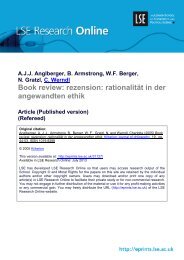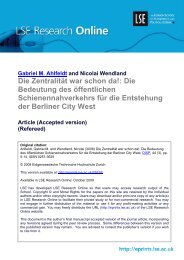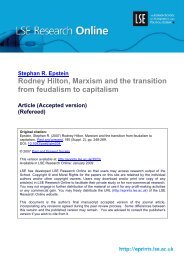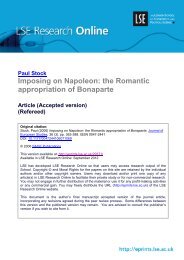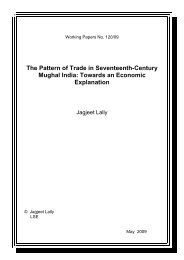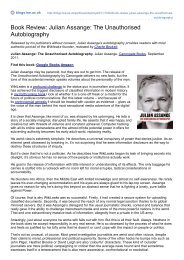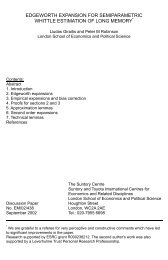Download (307Kb) - LSE Research Online
Download (307Kb) - LSE Research Online
Download (307Kb) - LSE Research Online
Create successful ePaper yourself
Turn your PDF publications into a flip-book with our unique Google optimized e-Paper software.
about policy were politically charged because of the links between market structure,<br />
media<br />
freedom and democracy.<br />
Comparative accounts of changing policy regimes for media showed that adjustments to<br />
the ICT paradigm had not been uniform (Hallin and Mancini, 2004; McQuail, 2002;<br />
McQuail and Siune, 1999; Venturelli, 1998). At the beginning of the 2000s, Verhulst<br />
(2002) argued, nevertheless, that there had been a paradigm shift in digital content<br />
regulation. ICT convergence had provided a new basis for many‐to‐many distribution,<br />
non‐linear programming, and the transnationalisation of media markets. With the<br />
development of many new digital platforms, followed by mobile and Internet access to<br />
media content, the competitive broadcast market model had also been exported<br />
globally. The bias of policy was to foster the competitiveness of firms in the audiovisual<br />
sector. As Hamelink (1996) observed, the result would be disempowering as the<br />
prospects of media producers with an explicit public service mandate waned in most,<br />
though not all, countries. This was so despite the proliferation of user generated content<br />
enabled by the digital revolution. Technological convergence has fostered industry<br />
convergence and policy convergence such that the greatest emphasis is on competition<br />
and<br />
innovation, consistent with the prevailing information society vision.<br />
In the context of information society developments, the spread of networks and new<br />
online applications has been associated with a flattening of hierarchies, the<br />
disappearance of capacity constraints, and empowered consumers. The bias in<br />
audiovisual media policy has been a presumption of fair competition as the guarantor of<br />
the public interest in media content. However, from a political economy perspective, the<br />
mere manifestation of competition in a given market is insufficient evidence of a<br />
weakening of the interests of firms in responding to the profit motive. Market power is<br />
associated with strategies that enable oligopolistic firms to entrench their positions,<br />
even in the face of destabilising change associated with a new techno‐economic<br />
paradigm. Firms in the audiovisual media market have incentives to monopolize the<br />
market by controlling its ‘choke points’ or gateways (Anderson, 2010; Mansell, 1996). As<br />
Noam, comments, in the face of the declining costs of digital equipment, ‘one major way<br />
for companies to deal with this price deflation is to try to reduce price competition. An<br />
oligopolistic market structure helps’ (Noam interviewed by Gassot, 2005: 153). When<br />
these firms succeed in creating a perception of scarce resources, this inevitably gives<br />
rise to implications for media diversity. The case of the expansion of the Murdoch News<br />
Corporation empire in the United Kingdom with its proposed acquisition of shares in<br />
8





